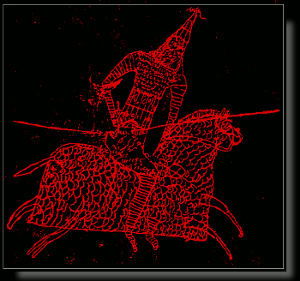The Battle of Badon
During the beginning of the sixth century, the Britons began gaining ground over the Saxon invaders. The earliest sources ascribe this shift in power to the Battle of Badon, a battle historians are unable to locate, but which most agree did take place. The tenth–century document the Annales Cambriae records Arthur as being the leader of this battle, and records that he carried the cross of Jesus Christ on his shoulders for three days and three nights, and the Britons were the victors.
This claim is clearly unbelievable. But most historians believe the Battle of Badon was a real, historical battle which did take place. It is mentioned in other, more reliable sources from this period, including ones which do not mention Arthur. A sixth–century monk named Gildas mentions it too.
Most records describe the battle as being a decisive victory which gave the Britons a strong foothold over the Saxons for a period of approximately thirty years. Most historians place the battle a decade or two before the Cambriae does, and archaeological evidence from this period indicates that many Saxon settlements were abandoned, and their frontier pushed back significantly.
Determining the location of the battle has been difficult. It was somewhere in southern Britain, and one popular suggestion has been an ancient hillfort above Liddington Castle, near the village of Badbury. Archaeology shows that its earthwork ramparts were refurbished at about the right time. Another suggestion is Solsbury Hill near Bath, where Geoffrey of Monmouth placed it.
Wherever the battle took place, another point of interest is what could have led to this swift change in victories of the Britons over the Saxons? Our only firsthand witness to the events of this period is a monk named Gildas. Gildas' writing is overly preachy, but since he was a witness to the events he writes about, he can usually be relied on for accurate information about the period. Several times in his writing, Gildas makes mention of armored horses. The majority of these references are not literal, but poetic, as when he compares a man who refuses to repent of his sins with a horse charging blindly into battle. But the fact that they are there at all, and that they appear so often seems to suggest that armored horses may have been a common sight in his time. And he does mention cavalry being used during the second rescue of Britain, which would have taken place in about 418.
If the Britons did use cavalry, it is unknown to us. But we do know that the Romans had used it. A type of Roman unit called a cataphract consisted of an armored horseman with both the rider and horse covered in mail. In 1891, an historian named Sir John Rhys hypothesized that a historical Arthur may have belonged to or revived a specific Roman command. In the 1930s, R. G. Collingwood took this a step further by suggesting that the change in victories could have been caused by a change in military tactics. We do know that the Anglo–Saxons fought on foot, and a mounted horseman would have been a terrifying sight in those days. A horseman would also have had the added advantage of swift mobility, which foot soldiers would lack.

On these grounds, more than one historian has suggested that Arthur may have been a Roman soldier who stayed on to help fight off the Saxons after the Empire withdrew, or else some individual who had a Roman military education, and used it to organize several successful battles against the Saxons. Indeed, "Arthur" is a Roman name, and one reason for believing he existed is that there are several individuals on record as having that name in a time when the older, pagan and Celtic culture was reviving, and Roman names were becoming uncommon. It can be verified that none of these individuals had any connection with one another. Thus, it seems that there may have been some military leader at this time who went by the name Arthur, and who had given the Britons such hope that they remembered him for centuries after.

